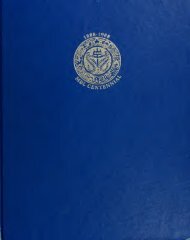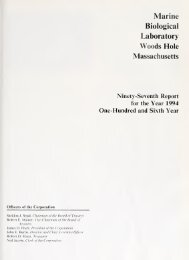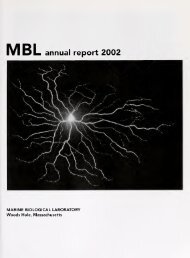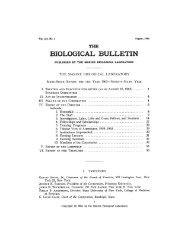38 researchBUMP staff, cont.PH.D. STUDENTSAngell, CarolynChick, Ben Yue (Benita)Crandall, EricCulbertson, JenniferDrew, JoshuaFisher, HeidiFox, SophiaGrady, SaraHolmes, GabrielleKoop-Jakobsen, KetilKinney, ErinLysiak, NadineMiller-Sims, VanessaNeeley, ElizabethNickles, ScottOlsen, YlvaPhilibotte, JasonRichlen, MindySkomal, GregorySteinbach, MollyTeichberg, MirtaYork, JoannaVISITING PH.D. STUDENTShank, BurtonMASTERS STUDENTSAnnett, BrendanBlinkoff, KevinBuckingham, JessicaCermak, MichaelDale, DhiraFox, LizaGardiner, JayneKinney, ErinLysiak, NadineO’Keefe, CatherinePardede, SintaPatell, SanayaPeacock, EmilySchacter, CarleyWeiss, EmilyZilinskas, KristinUNDERGRADUATES (Fall )Albright, LindseyBentley, KatherineBogner, KariBunnag, Ramida FaiCullen, PaulDacks, RachelDubofsky, ElizabethFabian, NioraFitzsimmons, JessicaFocht, RebecaFogel, AndrewForecki, JenniferGiresi, MelissaHammer, JuliaHansen, ClareKarl, KristinaMaamor, ShahrinazNadler, LaurenNg, AnnabellePfeiffer, VeraRobertson, RussellSandercock, MariaTaylor, LaurenVollrath, KristenVreeland, LaurenWalfoort, DavidWhitten, TorreyWilliams, LisaContinuedin sharks, Atema worked with DavidBodznick, a Whitman Investigator atthe MBL, to examine the interactionbetween signals from the lateral line andchemosensory structures. The work relieson sensitive neuro-telemetry tools thatpermit freely swimming animals to bestudied.Paul Barber studies the ecology andevolution of marine populations usinga genetic approach. His laboratoryhas focused on understanding howphysical oceanography shapes patternsof dispersal among populations of fishand invertebrates on the coral reefs ofIndonesia. These processes contributeto the high marine biodiversity thattypifies the region. Barber’s laboratoryworks closely with regional conservationorganizations to ensure that the results oftheir research have a positive impact onthe management of coral reef ecosystems.As part of his outreach effort, Barberdeveloped The Diversity Project, whichtakes under-represented minority studentsinto the field in Indonesia and into hislaboratory in Woods Hole (see THE DIVERSITYPROJECT at http://people.bu.edu/pbarber/Intro.htm).Phillip Lobel studies the evolution,behavior and ecology of fishes. Hisresearch examined several broad subjectsduring the year including fish reproductionand reproductive behavior relative tophysical oceanographic variables, predatorpreyrelationships in herbivores and theirrole in coral reef ecology, ciguatera in coralreef ecosystems, new species identificationand biogeography, fish bioacoustics, andthe environmental impact of naturalcatastrophes, pollution, and man-madehabitat alterations. Professor Lobel isfunded by the Department ofDefense and serves as their chiefscientist for issues concerningcoral reefs and the U.S. CoralReef Task Force.Gil Rosenthal’s work focuses on theevolution of visual communication infish. Recent work from his laboratory hassuggested that contaminants that reducewater clarity may interfere not only withvisual communication, but also withchemical signaling in fishes, leading tointerspecies mating and hybridization.During the year Rosenthal relocated hislaboratory to Boston in preparation formoving from BU to Texas A&M <strong>University</strong>in 2006.Ivan Valiela and his group have focusedon the linkages between land useon watersheds and alterations of thestructure and function of salt marshand mangrove ecosystems and coastalestuaries on Cape Cod, California, PuertoRico, Mexico, Panama, Brazil, Argentina,Portugal, and Italy. In particular theresearch has been concerned with theeutrophication of coastal ecosystemsand with the consequences of increasedland-derived nutrient loading that resultsfrom urban sprawl on watersheds. Usingdata on population density, wastewaterrelease, estuarine nitrogen, and othermeasures acquired over several decades,he and his students have modeled theseprocesses to predict future impacts and theconsequences of present-day land-use andland-management decisions. In addition,this group has worked on the populationdynamics of invertebrates, most recentlyhorseshoe crabs in particular, as well as theecology and physiology of macroalgae andseagrasses. Other work includes assessmentof the decadal impacts of chronicpetroleum exposure in salt marsh grasses,fiddler crabs and ribbed mussels, andtracing long-distance migration in rightwhales by use of stable isotope contentsin baleen. Valiela’s newest book, GlobalCoastal Change, will be published this yearby Blackwell Science Publishers.
esearch 39BUMP staff, cont.PublicationsBarber, PH; Bellwood,DR. 2005. Biodiversityhotspots: Evolutionaryorigins of biodiversityin wrasses (Halichoeres)in the Indo-Pacific andNew World Tropics.Molecular Phylogeneticsand Evolution 35: 235-253.Barber, PH; Moosa, MK;Palumbi, SR. 2005. Rapidrecovery of geneticdiversity on coral reefsand the temporal andspatial scale of larvaldispersal: Examples fromKrakatau. Proceedingsof the Royal Society ofLondon, Series B 269:1591–1597.Carmichael, RH; Valiela,I. 2005. Couplingof near-bottomseston and surfacesediment composition:Changes with nutrientenrichment andimplications forestuarine food supplyand biogeochemicalprocessing. Limnol.Oceanogr. 50: 97-105.Cole, ML; Kroeger, KD:McClelland, JW; Valiela,I. 2005. Macrophytesas indicators of landderivedwastewater:Application of a δ 15 Nmethod in aquaticsystems. Water ResourcesResearch 41: W01014,1-9.Gherardi, F; Atema, J.2005. Memory of socialpartners in hermit crabdominance. Ethology111: 271-285.Gherardi, F; Atema,J. 2005. Effects ofchemical context onshell investigationbehavior in hermitcrabs. J. Exp. Mar. Biol.Ecol. 320: 1-7.Gherardi, F; Tricarico,E; Atema, J. 2005.Unraveling the nature ofindividual recognitionby odor in hermit crabs.J. Chem. Ecol. 31: 2877-2896.Hauxwell, J; Cebrian,J; Valiela, J. 2005.Light dependence ofZostera marina annualgrowth dynamics inestuaries subject todifferent degrees ofeutrophication. Aquat.Bot. 84: 17-25.Johnson, M; Atema,J. 2005. The olfactorypathway for individualrecognition in theAmerican lobster,Homarus americanus.J. Exp. Biol. 208: 2865-2872.Jones, ME; Barber, PH.2005. Characterizationof microsatellite locifor the detection oftemporal genetic shiftswithin a single cohort ofthe brown demoiselle,Neopomacentrusfilamentosus. Mol. Ecol.Notes 5: 834-836.Lindquist, N; Barber,PH; Weisz, J. 2005.Epibiotic microbes asfood and defense formarine isopods: Uniquesymbioses in a hostileenvironment. Proceedingsof the Royal Society ofLondon, Series B 272:1209-1216.Miller-Sims, V; Delaney,M; Atema, J; Kingsford,MJ; Gerlach, G. 2005.DNA microsatellites inthe neon damselfish(Pomacentrus coelestis).Mol. Ecol. Notes 5:424-426.Miller-Sims, V; Delaney,M; Atema, J; KingsfordMJ; Gerlach, G. (2005)DNA microsatellitesin Acanthochromispolyacanthus. MolecularEcology Notes 5: 841-843.Randall, JE; Lobel, PS;Kennedy, CW. 2005.Comparative ecology ofthe gobies Nes longus andCtenogobius saepepallens,both symbiotic with thesnapping shrimp Alpheusfloridanus. Environ. Biol.Fish. 74: 119-127.Richlen, ML; Barber, PH.2005. A technique forthe rapid extraction ofmicroalgal DNA fromsingle live and preservedcells. Mol. Ecol. Notes 5:688-691.Ripley, JL; Lobel, PS.2005. Reproductivebehavior of theLake Malawi cichlidTramitichromisintermedius. Environ.Biol. Fish 73: 171–180.Rosenthal, GG;Lobel, P. 2005. FishCommunication. Ch 2 inBehavior and Physiologyof Fish. Edited bySloman, KA; Wilson,RW; Balshine, S. Vol 24:Fish Physiology. Pp 39-78.Elsevier Academic Press.Rosenthal, GG; Ryan,MJ. 2005. Assortativepreferences for stripepatterns in Danios. Anim.Behav. 70: 1063-1066.Shashar, N; Rosenthal,GG; Caras, T; Manor, S;Katzir, G. 2005. Speciesrecognition in theblackbordered damselfishDascyllus marginatus(Rüppell): An evaluationof computer-animatedplayback techniques. J.Exp. Mar. Biol. Ecol. 318:111-118.Valiela, I; Martinetto.P. 2005. The relativeineffectiveness ofbibliographic searchengines. BioScience 55:688-692.Wong, BBM; Fisher, HS;Rosenthal, GG. 2005.Species recognitionby male swordtails viachemical cues. Behav.Ecol. 16: 818-822.Wong, BBM; Bibeau, C;Bishop, K; Rosenthal,GG. 2005. Responseto perceived predationthreat in fiddler crabs:Trust thy neighbor asthyself? Behav. Ecol.Sociobiol. 58: 345-350.Wong, BBM; Rosenthal,GG. 2005. Shoal choicein swordtails whenpreferences conflict.Ethology 111: 179-186.SUMMER REU INTERNSAguila, Carolina, Valiela LabFoster, Sarah, Giblin LabFung-Kee-Fung, Lisa, MBLHalliday, Elizabeth, Woods HoleOceanographic InstitutionHattenrath, Theresa, Valiela LabPervaiz, Mohammed, Woods HoleResearch CenterShamberger, Lindsay, Atema LabSkolness, Sarah, Woods HoleOceanographic InstitutionVanderkruik, Rachel, Valiela LabWalker, Jeffrey, MBLVISITING INTERNS/VOLUNTEERSAkinronbi, Bolanle, Barber LabDeeg, Katherine, Atema LabFabian, Niora, Barber LabFindlay-Shirras, Katherine, Atema LabHashimoto, Daniel, Atema LabMuñoz, Martha, Barber LabMurawski, Jill, Valiela LabVISITING RESEARCHERSBertrand, Jean-Francois, Barber LabBush, Brian, Atema LabCastro, Paula Cristina de Oliveira, Valiela LabCastro Prieto, Aines del Camen, Rosenthal LabChavarria, Krystle, Rosenthal LabMartinetto, Paulina Maria del Rosario, Valiela LabSachse, Dirk, Golubic/Microbial Ecology courseWagner, Glenn, Barber Lab
- Page 1 and 2: MBL7 MBL StreetNon-profit Org.U.S.
- Page 5: contents1 report of the director an
- Page 8 and 9: 2 report of the director and ceoTha
- Page 10 and 11: 4 program profiles“Our lives are
- Page 12 and 13: 6 program profilesoffering unmatche
- Page 14 and 15: 8 program profilestraining pre and
- Page 16 and 17: 10 program profilesforging powerful
- Page 18 and 19: 12 program profilesengaging undergr
- Page 20 and 21: 14 program profilesexciting k-12 te
- Page 22 and 23: 16 researchresearchThe MBL is one o
- Page 24 and 25: 18 researchgenomes. The National Ae
- Page 26 and 27: 20 researchPublicationsAmaral Zettl
- Page 28 and 29: 22 researchThe High Cost of Coastal
- Page 30 and 31: 24 researchJohn Hobbie Named MBL Di
- Page 32 and 33: 26 researchwhitman centerThe Whitma
- Page 34 and 35: 28 researchA New Twist on Power Wal
- Page 36 and 37: 30 researchfellowshipsMBL Research
- Page 38 and 39: 32 researchAlbert and Ellen Grass F
- Page 40 and 41: 34 researchFriday Evening Lecture S
- Page 42 and 43: 36 researcharchitectural dynamics i
- Page 46 and 47: 40 researchmarine resources program
- Page 48 and 49: 42 researchMarine Resources Program
- Page 50 and 51: 44 researchprogram in molecular phy
- Page 52 and 53: 46 researchlaboratory of aquatic bi
- Page 54 and 55: 48 researchlaboratory of norman wai
- Page 56 and 57: 50 educationsummer coursesBiology o
- Page 58 and 59: 52 educationGreenberg, Everett, Uni
- Page 60 and 61: 54 educationMaul, Kristen, City Col
- Page 62 and 63: 56 educationPata, Veena, National I
- Page 64 and 65: 58 educationspecial topics coursesA
- Page 66 and 67: 60 educationMaiato, Helder, Institu
- Page 68 and 69: 62 educationBrower, Stewart, Univer
- Page 70 and 71: 64 educationFACULTYCurran, Sean, Ma
- Page 72 and 73: 66 educationGeunes-Boyer, Scarlett,
- Page 74 and 75: 68 educationSTUDENTSAparicio, Paul,
- Page 76 and 77: 70 educationother educational progr
- Page 78 and 79: 72 educationscholarship awardsIn 20
- Page 80 and 81: 74 educationCaswell Grave Scholarsh
- Page 82 and 83: 76 educationMilton L. Shifman Endow
- Page 84 and 85: 78 mblwhoi librarytrends, and curre
- Page 86 and 87: 80 financialsfinancialsreport of th
- Page 88 and 89: 82 financialsOperating History and
- Page 90 and 91: 84 giftsWe are grateful as well to
- Page 92 and 93: 86 giftsRestricted gifts(up to $9,9
- Page 94 and 95:
88 giftsMEMBER($1,000 - $2,499)Edwa
- Page 96 and 97:
90 giftsJohn E. Hobbie Fund for Sci
- Page 98 and 99:
92 giftsMr. and Mrs. J. Sterling Cr
- Page 100 and 101:
94 giftsLectureshipsJohn J. Cebra L
- Page 102 and 103:
96 gifts10th AnniversaryDr. Eva M.
- Page 104 and 105:
98 giftsMBL AssociatesThe Associate
- Page 106 and 107:
100 giftsMr. James K. TaylorMrs. Al
- Page 108 and 109:
102 giftsMBL Golf OutingIn July, MB
- Page 110 and 111:
104 giftsFellowships Established in
- Page 112 and 113:
106 giftsSemester in Environmental
- Page 114 and 115:
108 governance & administrationgove
- Page 116 and 117:
110 governance & administrationcorp
- Page 118 and 119:
112 governance & administrationDr.
- Page 120 and 121:
114 governance & administrationcoun
- Page 122 and 123:
116 governance & administrationadmi
- Page 124:
118 governance & administrationPhot
















